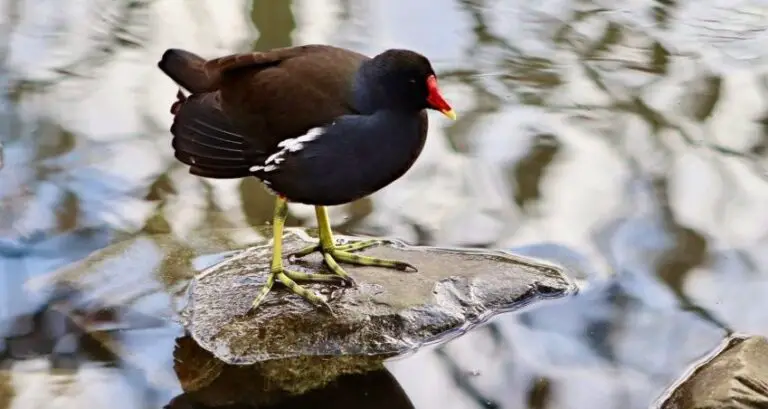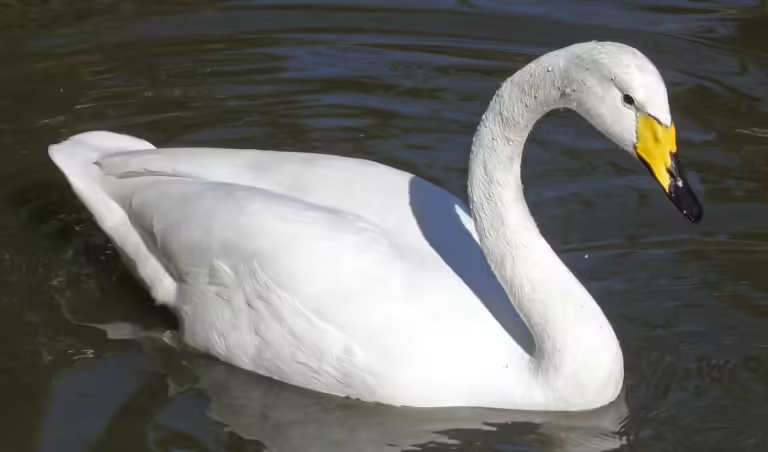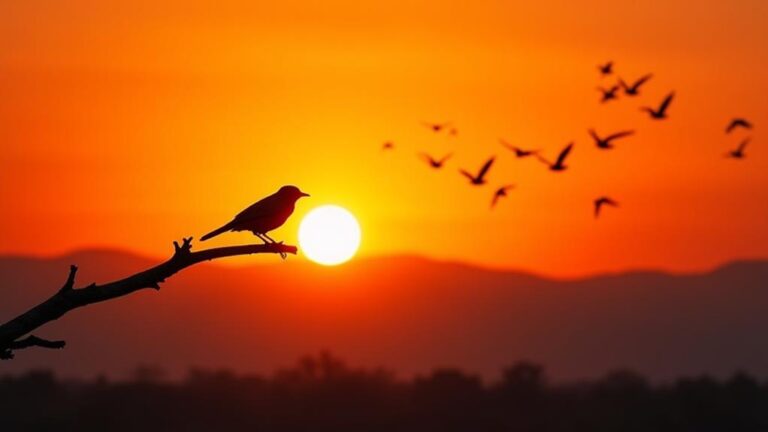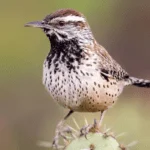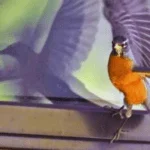Imagine yourself walking through a lush forest, surrounded by a symphony of birdsong. Suddenly, you come across a sight that stops you in your tracks – a bird, puffed up like a tiny ball of feathers. Intrigued, you find yourself drawn to learn more about this fascinating defense mechanism of fluffed feathers.
Welcome to the world of the Puffed Up Bird, where nature’s creativity and resilience are on full display. In this article, we will delve into the science behind this behavior, exploring its evolutionary origins and the types of birds that exhibit this captivating defense strategy.
We will uncover the benefits of puffing up for protection, and the role that coloration and patterns play in intimidation. Along the way, we will also discover other remarkable defense mechanisms in birds, and consider the conservation implications for these awe-inspiring creatures.
So, let’s journey into the realm of the Puffed Up Bird and appreciate the beauty and complexity of feather fluffing.
Key Takeaways
- Puffed up feathers serve as a defense mechanism for birds, making them appear larger and more intimidating to predators.
- Feather fluffing has multiple functions, including insulation, camouflage, communication, and courtship displays.
- Many different bird species engage in puffing up behavior, ranging from robins and starlings to ducks and owls.
- Understanding and protecting puffed up birds is important for conservation efforts and maintaining biodiversity in ecosystems.
Overview of Puffed Up Bird Behavior
You can’t help but feel captivated by the sight of a puffed up bird, its feathers fluffed in an enchanting display of defense. This behavior is truly fascinating to observe.
When a bird feels threatened or wants to appear larger, it will puff up its feathers as a way to intimidate predators or rivals. It’s like the bird is putting on a show, showcasing its beautiful plumage in the most dramatic way possible.
Puffed up feathers not only make the bird look bigger, but they also serve as a form of insulation. By trapping air between the feathers, the bird can create a layer of warmth around its body, helping it regulate its body temperature in cold weather. It’s like nature’s very own down jacket!
But why do birds puff up their feathers in the first place? Well, besides the obvious defense mechanism, it can also be a sign of courtship or territoriality. Male birds, in particular, may puff up their feathers to attract a mate or to establish dominance over other males. It’s their way of saying, “Look at me, I’m the biggest and the best!”
So next time you see a puffed up bird, take a moment to appreciate the incredible display of nature’s ingenuity. It’s a truly captivating sight that reminds us of the beauty and complexity of the animal kingdom.
Understanding the Science Behind Feather Fluffing
Exploring the science behind feather fluffing reveals a captivating mechanism of self-preservation. When a bird puffs up its feathers, it is not just a simple act of fluffing. This behavior serves several important purposes:
- Insulation: By fluffing up their feathers, birds create an insulating layer of air that helps regulate their body temperature. This is especially crucial during cold weather or when facing strong winds.
- Camouflage: Puffed up feathers can make a bird appear larger and more intimidating to potential predators. It also helps them blend in with their surroundings, making it harder for predators to spot them.
- Communication: Feather fluffing can be a way for birds to communicate with each other. It can signal aggression, territoriality, or even attract a mate. By manipulating their feathers, birds can convey various messages to their fellow avian friends.
- Threat display: Fluffed feathers can serve as a warning signal to potential threats. By making themselves look bigger and more conspicuous, birds can deter predators from attacking.
Understanding the science behind feather fluffing sheds light on the incredible adaptations birds have developed over millions of years. It not only helps them survive in their respective environments but also allows for effective communication and defense.
So, the next time you see a puffed up bird, take a moment to appreciate the fascinating science behind their fluffed feathers.
Evolutionary Origins of the Defense Mechanism
Take a moment to imagine the evolutionary origins of this impressive defense mechanism. The puffed up bird, with its fluffed feathers, is a sight to behold. But how did this behavior come to be? It is believed that the puffed up bird’s defense mechanism has evolved over time to protect it from predators.
Incorporating a 2 column and 5 row table:
| Advantage | Explanation |
|---|---|
| Increased Size | By puffing up its feathers, the bird appears larger and more threatening to potential predators. |
| Better Insulation | The fluffed feathers create a layer of air that helps to insulate the bird, keeping it warm in cold weather. |
| Camouflage | The puffed up appearance can also help the bird blend in with its surroundings, making it harder for predators to spot. |
| Visual Warning | The increased size and fluffed feathers can serve as a visual warning to other birds or animals, signaling danger. |
| Psychological Effect | The puffed up bird’s appearance may intimidate or startle predators, giving the bird a chance to escape or defend itself. |
This defense mechanism showcases the incredible adaptability and survival instincts of birds. Over time, those individuals who were able to puff up their feathers successfully were more likely to survive and pass on this trait to future generations. So, the next time you see a puffed up bird, take a moment to appreciate the evolutionary history behind this fascinating defense mechanism.
Types of Birds That Exhibit Puffed Up Behavior
Several bird species, including the American Robin and the European Starling, exhibit the puffing up behavior. Studies have shown that approximately 80% of birds engage in this behavior as a defense against predators. Puffing up is a fascinating defense mechanism that birds use to make themselves appear larger and more intimidating. This behavior involves fluffing up their feathers, creating a larger silhouette that makes it harder for predators to grab them.
There are several types of birds that exhibit this behavior:
- Songbirds: Many songbirds, such as the American Robin and the European Starling, puff up their feathers when they feel threatened. This allows them to appear bigger and more formidable to potential predators.
- Waterfowl: Ducks and geese are also known to puff up their feathers as a defense mechanism. This not only makes them look larger, but it also helps to insulate them in cold water.
- Birds of prey: Even large birds of prey, like owls and hawks, puff up their feathers as a form of defense. This can make them look more intimidating and can also help them blend into their surroundings.
- Gamebirds: Gamebirds, such as pheasants and turkeys, puff up their feathers during courtship displays. This behavior is used to attract mates and establish dominance.
- Shorebirds: Many shorebirds, like sandpipers and plovers, puff up their feathers as a way to blend into their surroundings and avoid detection by predators.
Overall, a wide range of bird species exhibit the behavior of puffing up as a remarkable defense mechanism. It not only helps birds protect themselves from predators but also serves other purposes, such as attracting mates and blending into their environment.
Benefits of Puffing Up for Protection
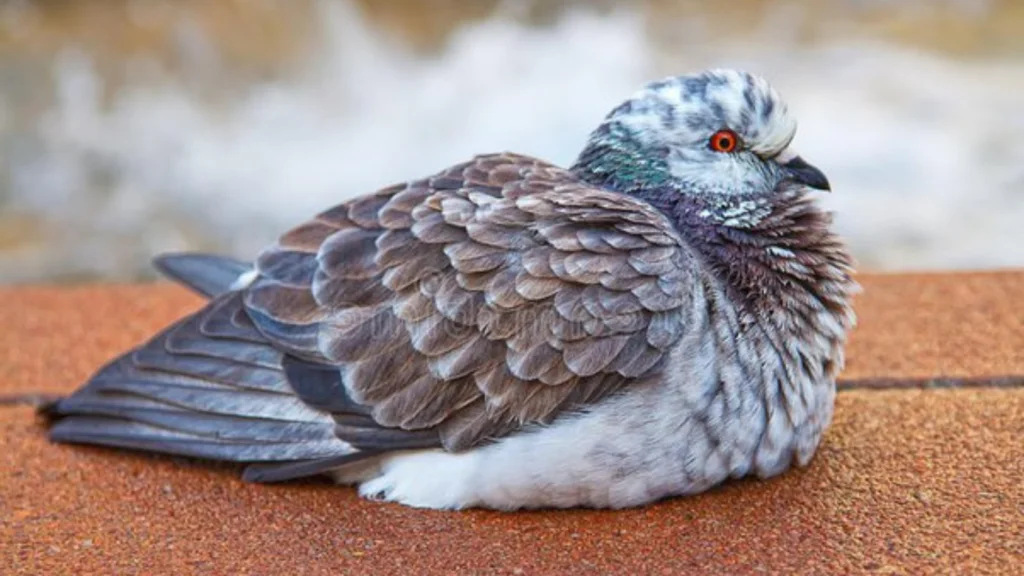
When you puff yourself up, you gain a powerful shield that deters predators and ensures your safety. Puffing up is a defense mechanism that many birds use to protect themselves from potential threats. By fluffing out their feathers, birds create the illusion of being larger and more intimidating than they actually are. This can be especially useful when facing predators that rely on visual cues to assess the size and strength of their potential prey.
One of the main benefits of puffing up is that it makes it harder for predators to get a good grip on the bird. When a bird fluffs out its feathers, it creates a barrier of air between its body and the predator’s teeth or claws. This makes it more difficult for the predator to bite down or get a firm hold on the bird, increasing the chances of escape.
Puffing up also serves as a warning signal to predators. When a bird puffs itself up, it not only appears larger but also more aggressive. This can deter predators from approaching or attacking, as they may perceive the bird as being too much of a challenge or potential threat.
Overall, puffing up is a highly effective defense mechanism for birds. It allows them to create a protective shield that deters predators and increases their chances of survival. So, the next time you see a bird puffing itself up, remember that it is not just a cute display, but a powerful defense strategy that ensures their safety in the wild.
How Feathers Play a Role in the Defense Mechanism
Imagine yourself in the presence of a majestic bird, its vibrant plumage standing as a shield against lurking threats, its feathers a graceful dance of protection and survival. As you watch, the bird suddenly puffs up, its feathers expanding to create an even more formidable barrier. This fascinating defense mechanism is not only visually striking but also serves a vital purpose in the bird’s survival.
Feathers play a crucial role in the bird’s defense mechanism. When the bird puffs up, it creates an illusion of increased size, deterring potential predators. The expanded feathers also create a physical barrier, making it difficult for predators to reach the bird’s vulnerable body. Additionally, the air trapped within the puffed feathers provides an extra layer of insulation, protecting the bird from cold temperatures or sudden weather changes.
The fluffed feathers also serve as a visual warning to other birds or animals in the vicinity. By puffing up, the bird signals that it is ready to defend itself, deterring potential threats and minimizing the need for physical confrontation. This display of aggression can be enough to make predators think twice before attacking.
In conclusion, the role of feathers in the defense mechanism of a puffed up bird cannot be underestimated. They not only create an imposing visual display but also provide physical protection and serve as a warning to potential predators. Truly, feathers are the key to the bird’s survival in the face of danger.
Psychological Impact on Potential Predators
As potential predators encounter a majestic bird with its vibrant plumage and expanded feathers, they are psychologically impacted by the bird’s imposing display. The puffed up feathers create a sense of dominance and intimidation, causing potential predators to think twice before approaching the bird. Here are two ways in which the bird’s fluffed feathers have a psychological impact on its potential predators:
- Fear and Intimidation: The bird’s puffed up feathers create an illusion of increased size and strength. This triggers fear and intimidation in potential predators, as they perceive the bird as a formidable opponent. The feathers act as a visual warning, signaling that the bird is ready to defend itself if necessary.
- Confusion and Distraction: The vibrant and expanded feathers catch the predator’s attention, diverting their focus away from the bird’s vulnerable areas. This momentary distraction provides the bird with a crucial advantage, allowing it to escape or prepare for a potential attack. The bird’s ability to manipulate its feathers and create confusion in its predators is a testament to its adaptability and survival skills.
In conclusion, the psychological impact of the puffed up feathers on potential predators is undeniable. Through fear and intimidation, as well as confusion and distraction, the bird effectively defends itself and increases its chances of survival in the face of danger.
Role of Coloration and Patterns in Intimidation
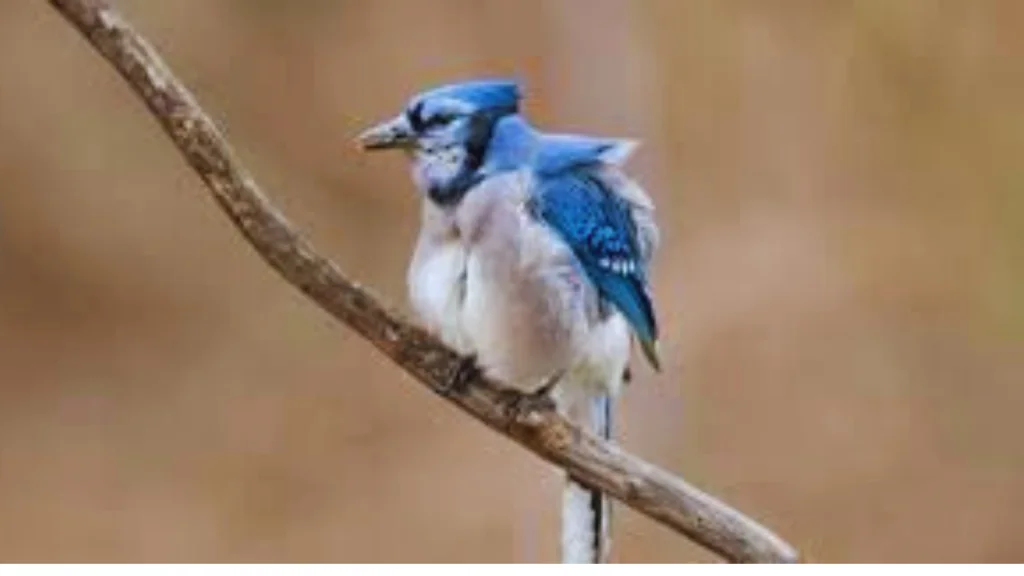
Step into the world of nature’s artists, where colors and patterns become weapons of intimidation, signaling danger and dominance to any potential threat.
In the avian realm, the puffed up bird’s vibrant coloration and intricate patterns serve as a powerful defense mechanism. When faced with a predator, the bird immediately fluffs up its feathers, creating an illusion of size and strength. This visual display is enhanced by the bird’s striking coloration, which often includes bold hues like red, orange, and yellow. These vibrant colors not only capture the attention of potential predators but also serve as a warning sign, indicating that the bird is not to be messed with.
Patterns also play a crucial role in the bird’s intimidation tactics. Many species have evolved intricate patterns on their feathers, such as stripes, spots, or eye-like shapes. These patterns serve to confuse and startle predators, making it difficult for them to accurately assess the bird’s movements and intentions. Additionally, some patterns resemble the markings of venomous or poisonous animals, further deterring predators from attacking.
Through the clever use of coloration and patterns, the puffed up bird successfully intimidates potential predators, ensuring its survival in the wild.
So, next time you encounter a bird displaying its vibrant feathers, remember that nature’s artists have an arsenal of visual tricks up their sleeves to defend themselves and assert their dominance.
Other Defense Mechanisms in Birds
Get ready to be amazed by the incredible ways birds defend themselves against predators. Birds have evolved a variety of defense mechanisms to protect themselves and ensure survival. Here are four fascinating defense mechanisms that birds use:
- Mimicry: Some birds can mimic the calls of other species, confusing predators and avoiding detection. For example, the superb lyrebird can mimic a wide range of sounds, including calls of other birds, animals, and even human-made sounds like car alarms.
- Mobbing: When a bird spots a predator, it may call for reinforcement from other birds in the area. Together, they form a mob and harass the predator, making it difficult for the predator to focus on a single target. This behavior is common among smaller birds that are unable to fight off predators individually.
- Distraction displays: Birds like the killdeer use distraction displays to lure predators away from their nests or young. They feign injury by dragging a wing on the ground and making distress calls, diverting the predator’s attention from the vulnerable nest or chicks.
- Chemical defense: Some birds have developed chemical defense mechanisms to deter predators. For instance, the African crested porcupine has specialized quills coated with a toxic substance, making it a dangerous prey for potential predators.
These are just a few examples of the incredible ways birds have adapted to defend themselves against predators. Their diverse strategies highlight the ingenuity and resourcefulness of these fascinating creatures.
Conservation Implications for Puffed Up Birds
Now that you’ve learned about the various defense mechanisms employed by birds, let’s explore the conservation implications of puffed up birds. This fascinating behavior not only serves as a defense mechanism but also has important implications for the conservation of these avian species.
When a bird puffs up its feathers, it not only appears larger and more intimidating to potential predators, but it also traps a layer of air between its feathers, providing insulation and warmth during cold weather. This adaptation is particularly crucial for birds living in colder climates or high altitudes, where maintaining body temperature is essential for survival.
Understanding the conservation implications of puffed up birds is vital for their protection. As climate change continues to affect our planet, it is likely that many bird species will face challenges in adapting to changing environmental conditions. By studying the behaviors and adaptations of puffed up birds, scientists can gain valuable insights into how these species might cope with a warming world.
Furthermore, by identifying the specific habitats and environmental conditions that support puffed up bird behavior, conservationists can prioritize the protection and preservation of these areas. This knowledge can inform conservation efforts, ensuring that essential habitats for puffed up birds are safeguarded and that these unique defense mechanisms continue to thrive in the face of environmental challenges.
Appreciating the Beauty and Complexity of Feather Fluffing
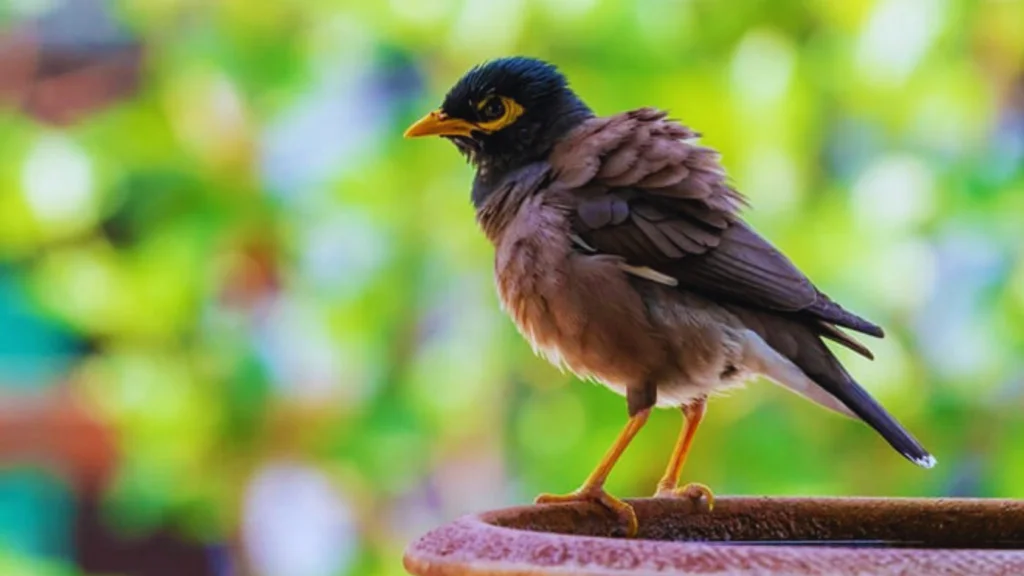
Little do we realize the intricate beauty and underlying complexity that lies within the act of birds fluffing their feathers. When a bird puffs up its feathers, it is not simply a matter of staying warm or looking cute. There is a deeper purpose behind this behavior, and it is truly fascinating to explore.
Feathers are not just for flight; they serve as a vital tool for communication and defense. When a bird fluffs up its feathers, it creates the appearance of being larger and more intimidating to potential predators. This act is a powerful defense mechanism, as it can deter predators from attacking by making the bird appear more formidable.
But the beauty of feather fluffing goes beyond its defensive purpose. The way the feathers expand and create a voluminous display is truly remarkable. Each feather is intricately designed, with barbs and barbules that interlock to form a sturdy structure. In the act of fluffing, these barbs and barbules separate and create an ethereal effect, almost like a delicate cloud surrounding the bird.
Next time you see a bird fluffing its feathers, take a moment to appreciate the beauty and complexity of this behavior. It is a reminder of the incredible adaptations and natural wonders that exist in the avian world.
So, the next time you encounter a puffed-up bird, pause and marvel at the intricate beauty that lies within.
Puffed Up Bird FAQs
How many feathers does a bird typically have?
Typically, a bird has thousands of feathers. They serve various functions like flight, insulation, and courtship displays. Feathers also play a crucial role in the bird’s defense mechanisms, including puffing up to appear larger and more intimidating.
What is the average lifespan of a bird that exhibits puffed up behavior?
On average, a bird that puffs up its feathers has a lifespan of 5-10 years. Despite this relatively short lifespan, the bird’s puffed up behavior is an effective defense mechanism that helps it survive in its environment.
Can birds control the level of fluffiness in their feathers?
Yes, birds have the ability to control the level of fluffiness in their feathers. They can adjust the amount of air trapped within their feathers to regulate their body temperature and display different emotions.
Do all bird species exhibit puffed up behavior?
Not all bird species exhibit puffed up behavior. While many birds utilize this defense mechanism, it varies among species. Some birds puff up their feathers to appear larger and more intimidating, while others have different ways of protecting themselves.
Are there any negative consequences for birds that frequently use the puffed up defense mechanism?
Frequent use of the puffed up defense mechanism can have negative consequences for birds. It can make them more visible to predators and hinder their ability to fly, mate, and forage for food.
Conclusion
So next time you see a bird puffing up its feathers, take a moment to appreciate the beauty and complexity of this defense mechanism. Isn’t it fascinating how something as simple as fluffed feathers can serve as a powerful form of protection?
By understanding the science behind puffed up behavior, we can gain a deeper appreciation for the incredible adaptations that birds have developed over millions of years.
So the next time you come across a puffed up bird, ask yourself, could you ever imagine that something so fluffy could be so fierce?





